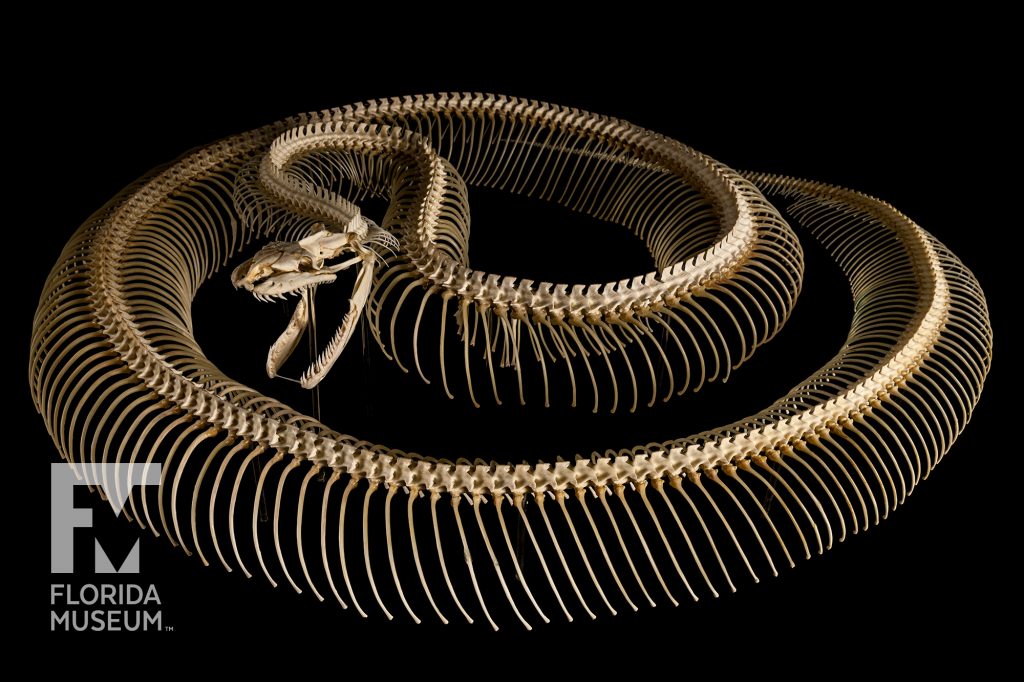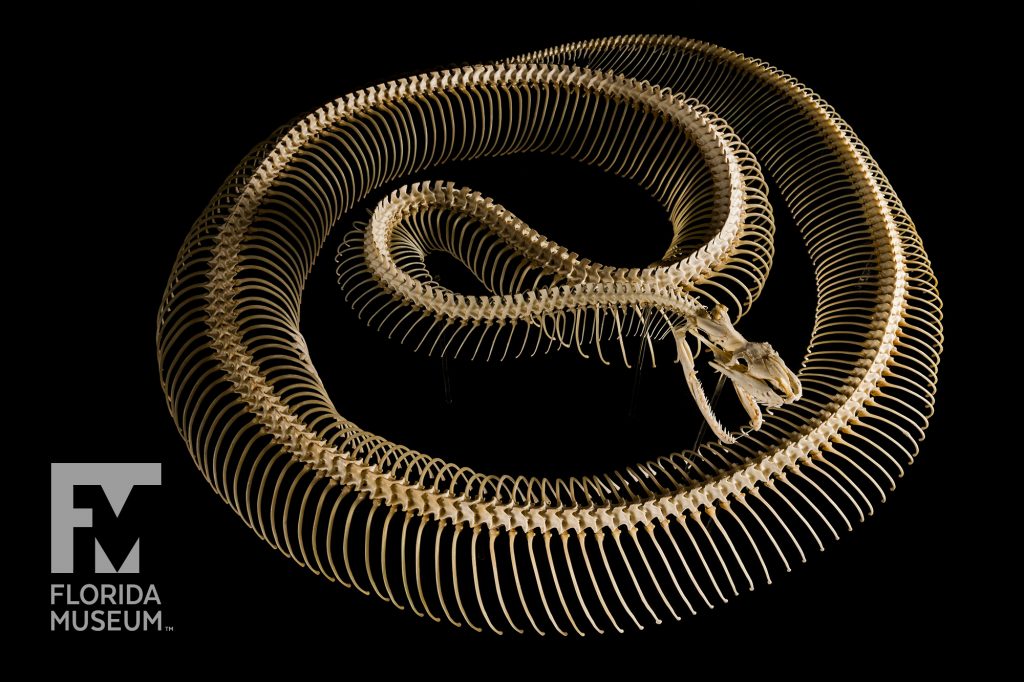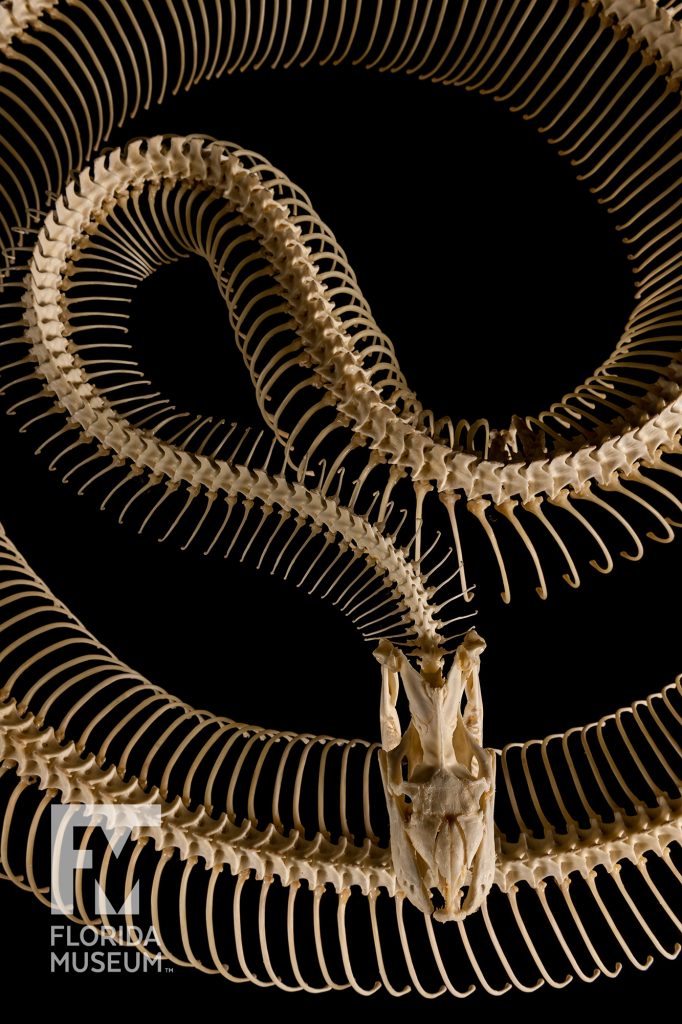This Python captured the world’s attention when park rangers found it and brought it to the Museum for study. At 17 feet 7 inches, this invasive snake was the largest found in Florida at the time, and also contained a record 87 eggs.
Summary
Burmese Python Skeleton (Python bivittatus)
From Everglades National Park, Florida, Mar. 2012
Collection
Story
This python captured the world’s attention when removed from Everglades National Park and euthanized by federal scientists in 2012. Brought to the Florida Museum for study, the 17-foot-7-inch, 164-and-a-half-pound snake is the largest Burmese python to have been found in Florida. A female, it also contained a record 87 eggs.
The Burmese Python is native to a vast reach of Asia stretching from northeast India to China, as well as portions of the southern Indonesian archipelago. A habitat generalist, it is equally at home on land and in water and is an excellent swimmer. In its native range, it occurs at extremes of elevation from the lowlands of Cambodia to the foothills of the Himalayas in Nepal. Small pythons, up to 8 feet in length, are good climbers that have been found high up in trees.
Released through the pet trade, both intentionally and by accident, the Burmese Python has been established and reproducing in South Florida since at least 2000. All pythons are constrictors, and the Burmese feeds on mammals, birds, reptiles and amphibians. Declines in mammal populations coincident with the arrival of the python in Everglades National Park suggest that the python is having a profound effect on the Everglades ecosystem, with survey detection rates for bobcats, opossum, raccoons and rabbits having dropped by 88 to100 percent in some areas.
Female Burmese Pythons may reach sexual maturity in as little as two years and lay, on average, a clutch of 40 eggs annually. The female wraps her body around the incubating eggs and maintains optimal temperature for the developing embryos through a process known as shivering thermogenesis; essentially using finely tuned contractions of her muscles to produce heat. Eggs hatch in about 60 days and the young are large, approximately 18 inches. Burmese Pythons in captivity have lived in excess of 20 years.
Efforts to control introduced Burmese Pythons in South Florida are made more difficult by the python’s cryptic appearance and behavior. The ornate pattern of the python’s skin, so attractive to snake enthusiasts, is excellent camouflage across a variety of environments and their crepuscular to nocturnal activity patterns mean they are most visible when people are at their fewest, and in the dark, at their poorest ability to detect them. Large reproductive females, especially those that have recently fed, may stay hidden for weeks at a time. Perhaps not surprisingly, widely publicized state-sponsored python hunts, while an excellent educational opportunity on the perils of introduced species, have resulted in the removal of far fewer introduced pythons than needed to control the population.
In its native range, the Burmese Python is hunted for its skin and meat as well as for the pet trade, and the species is in decline. A greater than 80 percent decline in Burmese Pythons over a 10-year period has been documented in Vietnam. Much more study has been dedicated to the life history and ecology of Burmese Pythons in South Florida than in their native range.
Robert Robins
Collection Manager, Ichthyology*
Snake Enthusiast
Florida Museum of Natural History
Additional Information
- Read: State record: 87 eggs in largest python from Everglades
- Read: Florida’s invasive amphibian and reptile problem leads world
- Rearticulating our Burmese Python specimen:
Exhibit
On display Sept. 23, 2017-Jan. 7, 2018, Rare, Beautiful & Fascinating: 100 Years @FloridaMuseum celebrated the Museum’s rich history. Each Museum collection was asked to contribute its most interesting items and share the stories that make them special. Though the physical exhibit is closed, this companion website remains online, providing an opportunity to experience the Florida Museum’s most treasured specimens.
Exhibit Area: Objects Tell Stories
Theme: Invasive Species of Florida
 Want to see more? Explore more than 300 breathtaking color photos of plants, animals, fossils and cultural heritage materials from the Florida Museum of Natural History’s collections in the award-winning book All Things Beautiful available from the University Press of Florida.
Want to see more? Explore more than 300 breathtaking color photos of plants, animals, fossils and cultural heritage materials from the Florida Museum of Natural History’s collections in the award-winning book All Things Beautiful available from the University Press of Florida.
*This title was accurate at the time the exhibit was on display in 2017. Please visit the collection website to verify current staff and student information.


